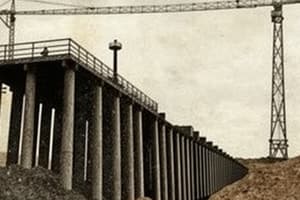Podcast
Questions and Answers
What is the primary reason for considering pile foundations over shallow foundations according to the text?
What is the primary reason for considering pile foundations over shallow foundations according to the text?
- Shallow foundations are limited in depth
- Shallow foundations cannot carry large building loads in poor soil conditions (correct)
- Pile foundations are more economical
- Pile foundations are easier to construct
In what type of ground conditions are piles typically recommended?
In what type of ground conditions are piles typically recommended?
- Seasonal ground conditions
- Stable ground conditions
- Poor ground conditions (correct)
- Waterlogged ground conditions
How is the load transfer mechanism described in the text when a pile is driven into a thick deposit of soil?
How is the load transfer mechanism described in the text when a pile is driven into a thick deposit of soil?
- Load is transferred through the circular base of the pile
- Load is transferred through the hollow core of the pile
- Load is transferred through the pile tip and shaft to the soil (correct)
- Load is transferred through the diamond-shaped head of the pile
What is a key advantage of driving a pile into bedrock, as described in the text?
What is a key advantage of driving a pile into bedrock, as described in the text?
What type of piles are installed at an angle to the vertical to resist lateral loads?
What type of piles are installed at an angle to the vertical to resist lateral loads?
What is the main difference between the pile load test arrangements shown in Figure 1.21a and Figure 1.21b?
What is the main difference between the pile load test arrangements shown in Figure 1.21a and Figure 1.21b?
In which type of soil do piles need to be driven beyond the depths where the problematic soil is present to avoid damage?
In which type of soil do piles need to be driven beyond the depths where the problematic soil is present to avoid damage?
Why are varying soil conditions and unreliable soil parameters mentioned as factors contributing to the variability in the ultimate load Qu?
Why are varying soil conditions and unreliable soil parameters mentioned as factors contributing to the variability in the ultimate load Qu?
Which structures may require foundations that can resist uplift?
Which structures may require foundations that can resist uplift?
What is the purpose of unloading the pile in steps after reaching the maximum load during a pile load test?
What is the purpose of unloading the pile in steps after reaching the maximum load during a pile load test?
For carrying lateral loads effectively, piles are more suitable than which type of foundation?
For carrying lateral loads effectively, piles are more suitable than which type of foundation?
Which component is used to anchor the horizontal reaction beam to the ground in Figure 1.21b of the pile load test arrangements?
Which component is used to anchor the horizontal reaction beam to the ground in Figure 1.21b of the pile load test arrangements?
Flashcards are hidden until you start studying
Study Notes
Pile Foundations vs. Shallow Foundations
- Pile foundations are considered over shallow foundations when the soil is unable to support the structural load.
Ground Conditions for Piles
- Piles are typically recommended in ground conditions with weak or unstable soil, such as soft clay, loose sand, or highly compressible soil.
Load Transfer Mechanism
- When a pile is driven into a thick deposit of soil, the load is transferred through the pile shaft to the surrounding soil, and then to the underlying soil layers.
Driving Piles into Bedrock
- A key advantage of driving a pile into bedrock is that it provides a reliable and stable foundation, as the load is transferred directly to the bedrock.
Inclined Piles
- Inclined piles, also known as battered piles, are installed at an angle to the vertical to resist lateral loads.
Pile Load Test Arrangements
- The main difference between the pile load test arrangements shown in Figure 1.21a and Figure 1.21b is that Figure 1.21b includes a horizontal reaction beam anchored to the ground.
Soil Conditions for Pile Depth
- Piles need to be driven beyond the depths where problematic soil is present to avoid damage in soils such as expansive clay or collapsing soil.
Variability in Ultimate Load
- Varying soil conditions and unreliable soil parameters contribute to the variability in the ultimate load Qu.
Structures Requiring Uplift Resistance
- Structures that may require foundations that can resist uplift include tall chimneys, slender towers, and offshore platforms.
Pile Load Testing
- The purpose of unloading the pile in steps after reaching the maximum load during a pile load test is to determine the pile's load-settlement behavior.
Comparison with Other Foundations
- Piles are more suitable for carrying lateral loads effectively than raft foundations.
Horizontal Reaction Beam Anchoring
- A ground anchor is used to anchor the horizontal reaction beam to the ground in Figure 1.21b of the pile load test arrangements.
Studying That Suits You
Use AI to generate personalized quizzes and flashcards to suit your learning preferences.




